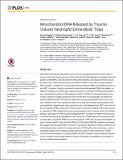| dc.contributor.author | Itagaki, Kiyoshi | en_US |
| dc.contributor.author | Kaczmarek, Elzbieta | en_US |
| dc.contributor.author | Lee, Yen Ting | en_US |
| dc.contributor.author | Tang, I. Tien | en_US |
| dc.contributor.author | Isal, Burak | en_US |
| dc.contributor.author | Adibnia, Yashar | en_US |
| dc.contributor.author | Sandler, Nicola | en_US |
| dc.contributor.author | Grimm, Melissa J. | en_US |
| dc.contributor.author | Segal, Brahm H. | en_US |
| dc.contributor.author | Otterbein, Leo E. | en_US |
| dc.contributor.author | Hauser, Carl J. | en_US |
| dc.date.accessioned | 2015-04-01T15:30:35Z | |
| dc.date.issued | 2015 | en_US |
| dc.identifier.citation | Itagaki, K., E. Kaczmarek, Y. T. Lee, I. T. Tang, B. Isal, Y. Adibnia, N. Sandler, et al. 2015. “Mitochondrial DNA Released by Trauma Induces Neutrophil Extracellular Traps.” PLoS ONE 10 (3): e0120549. doi:10.1371/journal.pone.0120549. http://dx.doi.org/10.1371/journal.pone.0120549. | en |
| dc.identifier.issn | 1932-6203 | en |
| dc.identifier.uri | http://nrs.harvard.edu/urn-3:HUL.InstRepos:14351319 | |
| dc.description.abstract | Neutrophil extracellular traps (NETs) are critical for anti-bacterial activity of the innate immune system. We have previously shown that mitochondrial damage-associated molecular patterns (mtDAMPs), including mitochondrial DNA (mtDNA), are released into the circulation after injury. We therefore questioned whether mtDNA is involved in trauma-induced NET formation. Treatment of human polymorphoneutrophils (PMN) with mtDNA induced robust NET formation, though in contrast to phorbol myristate acetate (PMA) stimulation, no NADPH-oxidase involvement was required. Moreover, formation of mtDNA-induced NETs was completely blocked by TLR9 antagonist, ODN-TTAGGG. Knowing that infective outcomes of trauma in elderly people are more severe than in young people, we measured plasma mtDNA and NET formation in elderly and young trauma patients and control subjects. MtDNA levels were significantly higher in the plasma of elderly trauma patients than young patients, despite lower injury severity scores in the elderly group. NETs were not visible in circulating PMN isolated from either young or old control subjects. NETs were however, detected in PMN isolated from young trauma patients and to a lesser extent from elderly patients. Stimulation by PMA induced widespread NET formation in PMN from both young volunteers and young trauma patients. NET response to PMA was much less pronounced in both elderly volunteers’ PMN and in trauma patients’ PMN. We conclude that mtDNA is a potent inducer of NETs that activates PMN via TLR9 without NADPH-oxidase involvement. We suggest that decreased NET formation in the elderly regardless of higher mtDNA levels in their plasma may result from decreased levels of TLR9 and/or other molecules, such as neutrophil elastase and myeloperoxidase that are involved in NET generation. Further study of the links between circulating mtDNA and NET formation may elucidate the mechanisms of trauma-related organ failure as well as the greater susceptibility to secondary infection in elderly trauma patients. | en |
| dc.language.iso | en_US | en |
| dc.publisher | Public Library of Science | en |
| dc.relation.isversionof | doi:10.1371/journal.pone.0120549 | en |
| dc.relation.hasversion | http://www.ncbi.nlm.nih.gov/pmc/articles/PMC4361684/pdf/ | en |
| dash.license | LAA | en_US |
| dc.title | Mitochondrial DNA Released by Trauma Induces Neutrophil Extracellular Traps | en |
| dc.type | Journal Article | en_US |
| dc.description.version | Version of Record | en |
| dc.relation.journal | PLoS ONE | en |
| dash.depositing.author | Itagaki, Kiyoshi | en_US |
| dc.date.available | 2015-04-01T15:30:35Z | |
| dc.identifier.doi | 10.1371/journal.pone.0120549 | * |
| dash.authorsordered | false | |
| dash.contributor.affiliated | Hauser, Carl | |
| dash.contributor.affiliated | Itagaki, Kiyoshi | |
| dash.contributor.affiliated | Kaczmarek, Elzbieta | |
| dash.contributor.affiliated | Otterbein, Leo | |


